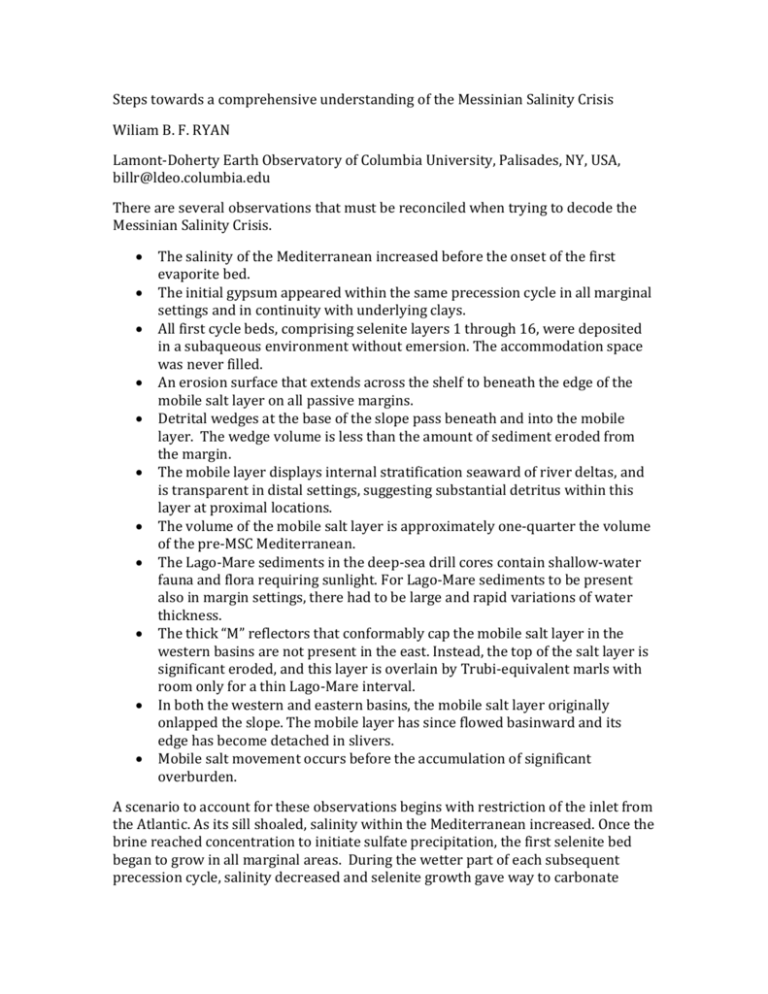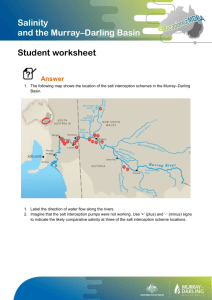Messinian Abstract - Lamont
advertisement

Steps towards a comprehensive understanding of the Messinian Salinity Crisis Wiliam B. F. RYAN Lamont-Doherty Earth Observatory of Columbia University, Palisades, NY, USA, billr@ldeo.columbia.edu There are several observations that must be reconciled when trying to decode the Messinian Salinity Crisis. The salinity of the Mediterranean increased before the onset of the first evaporite bed. The initial gypsum appeared within the same precession cycle in all marginal settings and in continuity with underlying clays. All first cycle beds, comprising selenite layers 1 through 16, were deposited in a subaqueous environment without emersion. The accommodation space was never filled. An erosion surface that extends across the shelf to beneath the edge of the mobile salt layer on all passive margins. Detrital wedges at the base of the slope pass beneath and into the mobile layer. The wedge volume is less than the amount of sediment eroded from the margin. The mobile layer displays internal stratification seaward of river deltas, and is transparent in distal settings, suggesting substantial detritus within this layer at proximal locations. The volume of the mobile salt layer is approximately one-quarter the volume of the pre-MSC Mediterranean. The Lago-Mare sediments in the deep-sea drill cores contain shallow-water fauna and flora requiring sunlight. For Lago-Mare sediments to be present also in margin settings, there had to be large and rapid variations of water thickness. The thick “M” reflectors that conformably cap the mobile salt layer in the western basins are not present in the east. Instead, the top of the salt layer is significant eroded, and this layer is overlain by Trubi-equivalent marls with room only for a thin Lago-Mare interval. In both the western and eastern basins, the mobile salt layer originally onlapped the slope. The mobile layer has since flowed basinward and its edge has become detached in slivers. Mobile salt movement occurs before the accumulation of significant overburden. A scenario to account for these observations begins with restriction of the inlet from the Atlantic. As its sill shoaled, salinity within the Mediterranean increased. Once the brine reached concentration to initiate sulfate precipitation, the first selenite bed began to grow in all marginal areas. During the wetter part of each subsequent precession cycle, salinity decreased and selenite growth gave way to carbonate sedimentation. The increasing density of the brine, thickest above the basin floors, induced a load on the lithosphere, causing basin centers to subside and peripheral bulges to emerge. The bulges further restricted the entry of Atlantic water, thus concentrating the brine towards halite saturation. The concentration added to the brine load so that eventually a combination of peripheral uplift and eustacy closed or severely restricted the inlet. Evaporative drawdown of the brine accelerated halite precipitation. Drawdown during halite precipitation accounts for the timing of the emergence of the shelves after the first cycle gypsum, onset of massive erosion, delivery of detritus into the salt layer, the observed increase in the thickness of the salt layer with greater depth below today’s sealevel and the total volume of salt. Formation of the mobile salt layer ceased when the brine had mostly evaporated. The only remaining sources of water were rivers and spillage from the Paratethys. Gypsum and halite on the exposed margins were eroded or dissolved and re-deposited as clastics, as well as re-precipitated to form the “M” reflectors with the second cycle evaporates. The load of mobile layer, when combined with the weight of the returning Pliocene water, further depressed the basin centers so that the accumulated salt flowed towards its depocenter under its own weight. This phenomenon explains the early mobility. RCMBNS 21013 email IstanbulRCMNS2013 https://www.arber.com.tr/rcmns2013.org/index.php/home











